Here's the Deal with Homemade Almond Milk
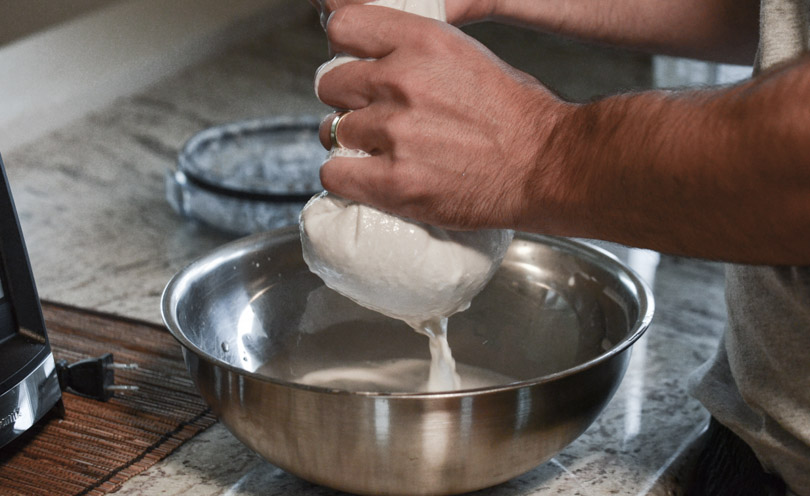
For 99% of us, homemade almond milk won’t replace store-bought.
But here’s the deal:
Homemade almond milk is unbelievably delicious. And in certain situations, there’s nothing better.
Before you read why homemade almond milk is so great, here's what you need
You need two things to make homemade almond milk.
- A blender. We use our Vitamix, but don’t let not having one stop you.
- A nut milk filtration bag.
Oh, and a third thing. You need to trust us that the process of making it is worth it. 🙂
Quick background: I used to think homemade almond milk was ridiculous
Homemade almond milk?
Why? (Aside from being officially 100% dairy free!)
Why make your own when you can buy cartons at the grocery store?
Unlike homemade green smoothies which cost MUCH less than store-bought, homemade almond milk is actually more expensive. And that doesn’t even factor the cost of time!
Not to mention, store-bought is fortified with calcium.
Well, my friends, logic is not part of this equation.
Video: Almond Milk: What’s actually inside!
Here’s why homemade milk is so great
Homemade almond milk is (in the words of Chef Carolyne, with me in the video below):
- Luscious.
- Thick.
- Bursting with creamy flavor.
It tastes nothing like store-bought.
And guys, the color is so vibrant. The brightest, most beautiful white you’ve ever seen.
With nothing but almonds and water! So, so easy.
The best way to use homemade almond milk
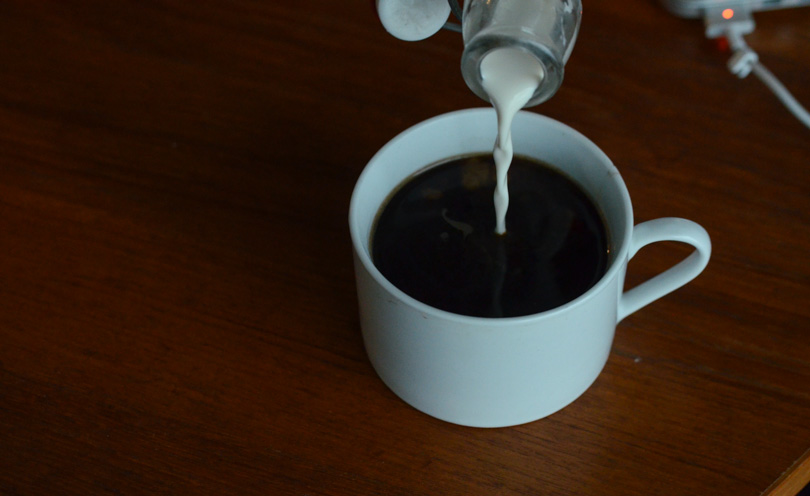
Add it to coffee. A bit of homemade almond milk in coffee is unbelievably delicious.
It makes for the richest and creamiest you’ve ever had. Yes, creamier than using cream from cow’s milk.
Normally, I like my coffee black. But if there’s homemade almond milk available, it’s tough to say no.
More great uses for homemade almond milk
What are some great uses? As you’d expect, the following are fabulous with homemade almond milk:
- Smoothies.
- Cereal.
- Baked goods.
- Really, anytime a recipe asks for milk.
But let’s get one thing out of the way. It may not be realistic to exclusively use homemade almond milk.
We make a daily smoothie with almond milk. For those, we still use store-bought almond milk from a carton.
Perhaps someday we exclusively use homemade. It really is one of our favorite Vitamix recipes.
But until then, we’ll make a batch every week and use it to make our coffee out-of-this-world delicious.
Go make some, people. Go make some today!
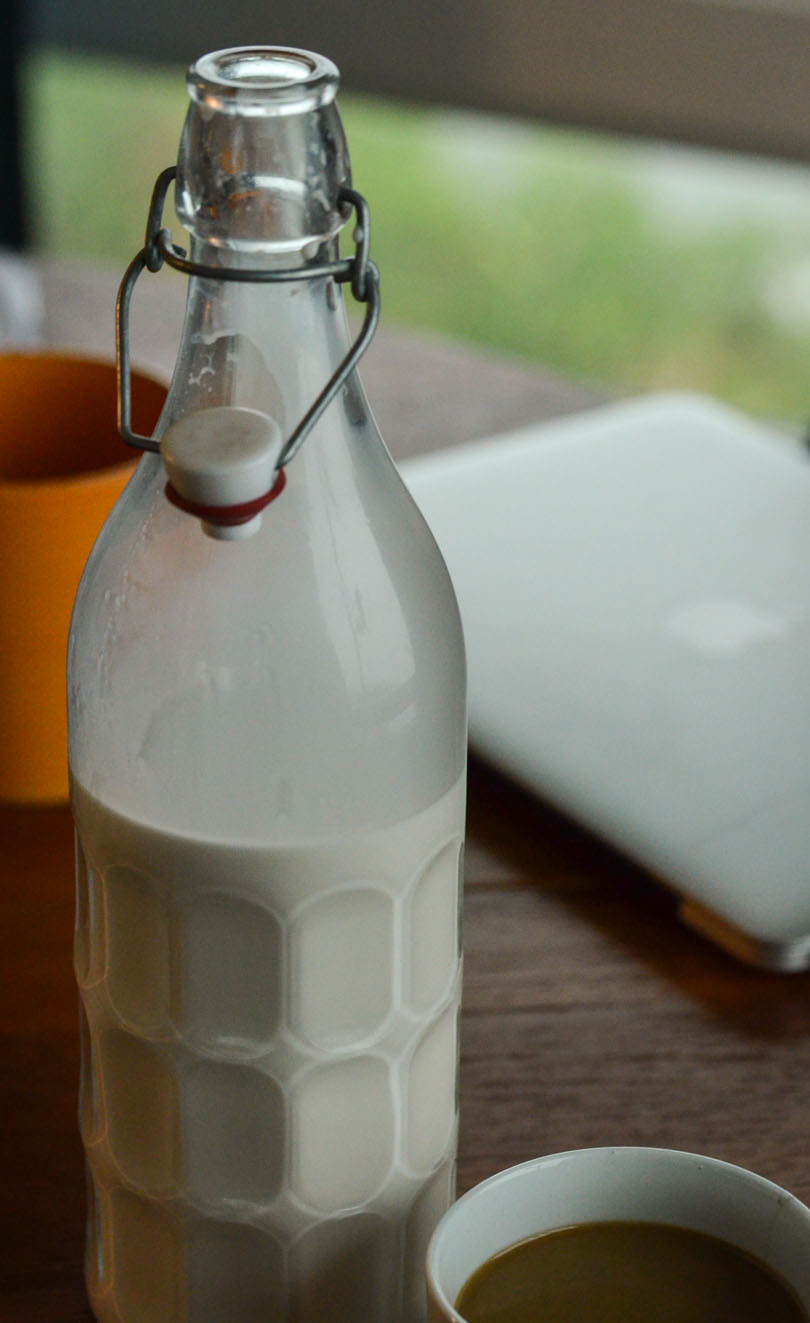
Video: Introduction to (and demonstration of) homemade almond milk in a Vitamix
Highlights from the video
- Why you want to soak the almonds: 00:47
- What varieties of homemade almond milk you can make: 1:44
- What you can do with the almond pulp: 2:14
- Why the filtration bag is better than a cheese cloth: 3:38
- The shortcut if you’re making a smoothie: 4:07
- What happens when you eat the pulp raw: 5:14
- Side-by-side comparison between store-bought almond milk and homemade almond milk: 6:28
- Comparison from nutritional standpoint: 9:08
Want more useful tips? Here ya go.
Recipe
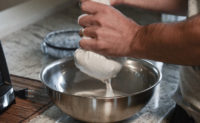
Homemade Almond Milk
Homemade almond milk that's thick, luscious, and bursting with flavor.
Almonds,Ingredients:
- raw almonds - 1 cup (135g), soaked
- water - 3 cups (700 ml)
Instructions:
TOOLS:
- A blender (Vitamix 5200 being shown in the video, A3500 is what we uses these days)
- Filtration bag (this one from Vitamix website shown in video, but any one will do)
PREP:
- Soak almonds in water for 8 – 12 hours
- Strain them (not with filtration bag, just a normal strainer)
- Rinse soaked almonds with cold water
METHOD:
- Add soaked almonds to your blender
- Add water
- Blend for 45 seconds
- Pour everything through filtration bag and squeeze it all through
- Serve chilled
NOTES:
- You can store in the refrigerator up to four days
- Save the pulp! Use it for baking or cooking
Useful tips for Homemade Almond Milk
Get a filtration bag. You will not be able to make homemade almond milk with cheese cloth. (We tried it recently while away and without our filtration bag. It was a total failure.)
Be sure to use raw almonds, not roasted.
Soaking almonds may seem strange, but it’s actually quite simple. Put almonds into a bowl submerged in water.
And remember that you can use the pulp for enhancing baked goods. After all, there’s a ton of good nutrients left in that almond pulp.

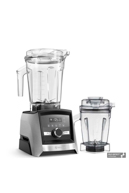
Note: I use dairy milk and cream regularly and have no reason to switch to a plant milk. I can’t find any benefit nutritionally, compared to milk from happy cows or goats (backyard hobby farm). If you compare with big ag milk production, then I can understand why it would be good to switch.
I made some almond milk after watching this video. Although I don’t agree on everything you said about the properties of homemade almond milk, it is much better than store-bought. I wouldn’t call it luscious and creamy (compared to dairy) but it is very good. I typically use dairy half and half in my coffee and I did not think this almond milk would be good in coffee but it really is. I could switch over to it easily.
My only concern is I use dairy milk (with oatmeal, etc.) mainly for the protein content. After straining all of the almond meal out of the milk, there’s really no protein left to speak of. :/ I wonder if adding a plant based protein powder would ruin the pleasant taste and texture of the homemade almond milk. I suppose so.
I make great almond milk about once a week thanks to this video. 5 hours is enough soaking time for naturally sweet almond milk. Avoid allowing fermentation.
Do not blend the mixture past a slightly warm point. 38 degrees Celsius or 100 degrees Fahrenheit is a good point to stop blending.
Judging by touch, during blending if you can feel warmth on the Vitamix vessel but it is not too hot to keep touching, that is when you can stop blending the mixture.
You want to avoid actually cooking the liquid. Otherwise the resulting almond milk’s texture will be a bit slimy.
You can improve the texture of the almond milk if you replace one cup of water with a 1.5 cups of ice. This will allow you to blend longer before reaching the 100 Degrees Fahrenheit limit.
Warning: If you soak the almonds more than 6 hours at room temperature fermentation will begin. The result will be a sour almond milk.
The intensity of the sourness will be stronger the longer the almonds soak.
Warning: Do not let the mixture stand. Squeeze out the mixture immediately. Otherwise the mixture will ferment rather quickly.
If you allow fermentation, the milk’s shelf life will dramatically shorter. It will become undrinkable in as little as 3 days. Even when refrigerated immediately after processing.
Made properly and immediately refrigerated, I have had almond milk remain good for as long as 10 days.
Oh yes, use the purest water possible.
Great advice! Thanks. Wondered if it would have an issue if over blended or too warm.
Any known issues when soaking almonds in water for over 24hr in the fridge?
I just watched the video and I think you did just fine. I have a Vitamix and love it for everything. I just bought the InstantPot Ace Plus blender for $129 (mostly for making hot soups) on Amazon. I have not tried to make Almond Milk in it yet however, from the videos I’ve seen about the Ace blender, it supposedly does a great job. If that’s the case, it’s a less expensive alternative to the Vitamix.
Let me know how it goes and I’ll add it to our Vitamix alternatives page
This was my first encounter with Lenny gale. If this video is a representation of his on screen work, I would recommend getting a different person in front of the camera. He does not listen to the woman he is working with. A few examples of this include the following. She tells him to try the store bought almond milk and he reaches for the other. She has to redirect him as he reaches for it again after she tells him again. He also makes multiple inane comments after she puts ice cubes in the almond milk. She tells him the purpose is to chill it and he says something about an alcoholic beverage. And he continues to make comments about the ice that demonstrates he is not listening to what she is saying. Had I been the person in charge of hiring talent, he would have been fired.
Thanks for watching, Pat. Wishing my more recent videos were your first impression of me
I was excited to finally use up the last of my store bought almond milk so I could make this 🙂
I used 1 cup organic raw almonds and 5 cups of water which gave the perfect consistency to pour on my granola.
I figured it was about US$1.75 per liter. I’ve never seen organic almond milk for less than $3 where I live.
If I can find a good use for the pulp it will be an even better deal!
Also, since I buy almonds in the bulk section, there’s no packaging. I have my doubts that those milk boxes actually get recycled.
And the questionability of recycling promises! Another great point
Agreed, Bonnie. I will never buy almond milk again. BTW, after I soak the almonds, I pop them out of the skin, then blend.
This sounds like a great idea since the skins are the bitter part of the nut.
I keep seeing articles saying almond milk is cheaper store bought. That is such a misunderstanding. A cup of almonds is 530 calories. Let’s say for simplicity that your recipe makes exactly 4 cups. Each 8 ounce serving will have 132 calories. A cup of almond milk from Trader Joe’s has 40 calories per 8 ounces! From Costco only 30 calories!! They are really selling you thickeners, not almonds. The number of almonds in one Costco container of milk is less than one serving. Less than 25 almonds!!
Great example. I think we’ll make a video about this
If you strain the pulp out like I do, the calories are probably less.
It’s still cheaper than store bought for me.
I don’t know about where you are, but here (Canada) store bought almond milk is definitely more expensive. Homemade, though fattier, is devoid of questionable additives, and tastier! The secret is in the blender though. It doesn’t have to be a vitamix, but no amount of blending in a cheap blender will give you quality creamy milk. I know from this experience. It’s really not that much of a hassle. 🙂
Great points — less costly and much tastier